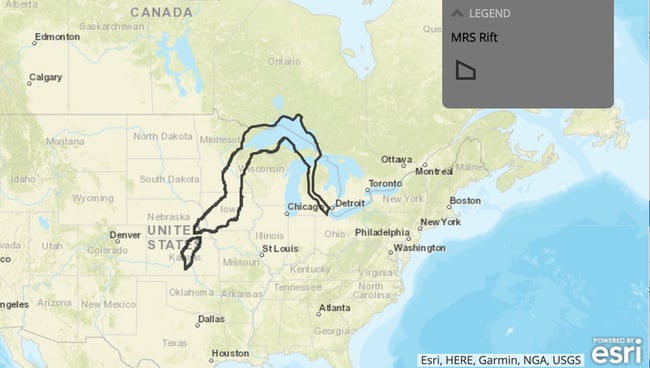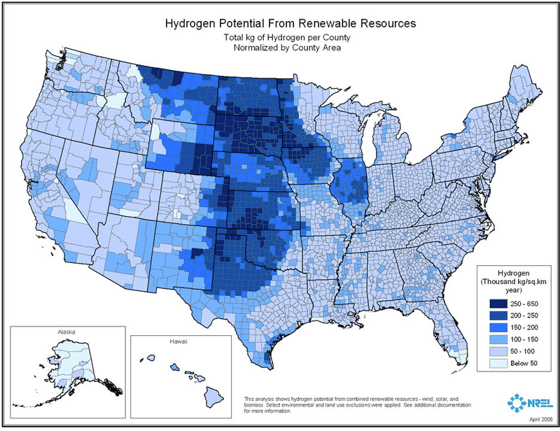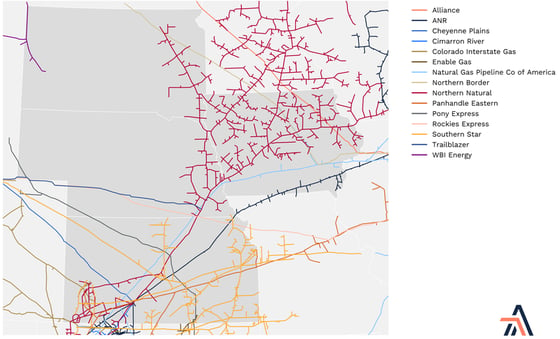Pipelines Positioned for Transport of Hydrogen – Green and Maybe White Hydrogen
Originally published for customers April 14, 2023
What’s the issue?
Hydrogen is seen by many as a low-carbon fuel that will be critical for net-zero goals. It is expected to be essential for hard to electrify applications, such as steel production, but also as a fuel source for dispatchable electricity. Conventional wisdom is that hydrogen does not exist in nature here on earth but must be produced through methods that either require a lot of energy or produce a lot of carbon.
Why does it matter?
Some entrepreneurs have begun to question the conventional wisdom and believe that there are areas on the earth where naturally occurring hydrogen can be extracted in a method similar to that used for natural gas.
What’s our view?
The concept of natural hydrogen, which has been assigned the color white in the color palette used for hydrogen, is only in its infancy. If it exists here in the U.S., it is expected to occur in an area in the Midwest or along the East Coast. However, the same area in the Midwest has been identified as a key resource for wind energy, which is essential for producing green hydrogen. Therefore, pipelines located in the Midwest, particularly in Kansas, Nebraska and Iowa, may want to consider the potential for the development of hydrogen along their pipeline routes.
Hydrogen is seen by many as a low-carbon fuel that will be critical for net-zero goals. It is expected to be essential for hard to electrify applications, such as steel production, but also as a fuel source for dispatchable electricity. Conventional wisdom is that hydrogen does not exist in nature here on earth but must be produced through methods that either require a lot of energy or produce a lot of carbon. Some entrepreneurs have begun to question the conventional wisdom and believe that there are areas on the earth where naturally occurring hydrogen can be extracted in a method similar to that used for natural gas.
The concept of natural hydrogen, which has been assigned the color white in the color palette used for hydrogen, is only in its infancy. If it exists here in the U.S., it is expected to occur in an area in the Midwest or along the East Coast. However, the same area in the Midwest has been identified as a key resource for wind energy, which is essential for producing green hydrogen. Therefore, pipelines located in the Midwest, particularly in Kansas, Nebraska and Iowa, may want to consider the potential for the development of hydrogen along their pipeline routes.
Hydrogen Must Be Produced
The website for the U.S. Department of Energy’s Hydrogen and Fuel Cell Technologies Office espouses the conventional wisdom about hydrogen. It simply states that hydrogen is “an energy carrier, not an energy source” because hydrogen doesn’t “exist by itself in nature and must be produced from compounds that contain it.” Thus, the department’s entire focus is on three methods for producing hydrogen using other energy sources, including fossil fuels, biomass and renewable energy to extract hydrogen from water.
In 2020 we discussed the many colors of hydrogen in Can Natural Gas Pipelines Facilitate a Conversion to Hydrogen as a Fuel? That discussion focused on the three most common colors used to describe hydrogen, gray, green and blue. Gray hydrogen is produced from fossil fuels, like natural gas. Blue also uses fossil fuels, but captures and sequesters the carbon dioxide emitted during the production process. Green is considered the cleanest as it uses renewable energy to split the hydrogen from water and emits no carbon dioxide in the process.
What About White Hydrogen?
At about the same time we were writing about those colors of hydrogen, an academic paper was published titled, The occurrence and geoscience of natural hydrogen: A comprehensive review. The paper was authored by an entrepreneur looking to develop natural hydrogen projects around the world. The paper begins by noting the “existing prejudice that free hydrogen in nature is rare, and descriptions of the few known discoveries are anecdotal and for some reason garner very little notice.” However, the paper goes on to gather evidence of natural hydrogen, which has been assigned the color white in other discussions, throughout the world. Based on its own examination of the research, the government of South Australia, a state in the southern central part of Australia, modified its regulations in February 2021 to allow companies to obtain a permit to explore for natural hydrogen and to allow the transmission of hydrogen or compounds of hydrogen under its transmission pipeline provisions.
These studies have postulated that naturally occurring hydrogen will likely occur here in the U.S. in two areas; one area is the 1,100 million-year-old Midcontinent Rift System (MRS), which the U.S. Geological Survey describes as “one of the world's great continental rifts, [which] contains a unique assemblage of magmatic and hydrothermal mineral deposits.”

Source: https://geonarrative.usgs.gov/mrs_mineral_deposits/
One company has drilled an exploratory well in Nebraska and indicated on April 3, 2023 that it hopes to provide the market with an update on the results of that well in the near future. However, whether white hydrogen exists or not, the same general area of the country is also considered to be the most likely location for the development of green hydrogen resources because of the abundance of wind energy in the region.

As seen above, many of the same states where there is the purported potential for white hydrogen already are expected to be a key source for green hydrogen because of the tremendous potential for wind energy. In fact, just this week the Washington Post noted that “Iowa now generates most of its electricity from wind farms, more than enough to export to other states.”
Lack of Electric Transmission May Benefit Pipeline Transportation
In both MISO Shows Reforms Are Desperately Needed to Interconnection Queueing and The Path to Net Zero Runs Through the Electric Grid, Which is a Problem, we have noted that a key hurdle wind energy faces is the need for electric transmission to move the power from the sources in the Midwest to the demand centers on the coasts. However, one person’s problem is another person’s opportunity. If the wind resources in the upper Midwest can be used to generate green hydrogen rather than electricity, that hydrogen could then be transported to power plants that are already connected to the power grid nearer to the demand centers. The hydrogen could likely be blended into the current natural gas stream and reduce the emissions at an existing plant or potentially in the future could be transported by pipeline to pure hydrogen power plants already connected to the grid and closer to the demand centers.

A quick look at the existing pipeline system shows there are a number of pipelines that could take advantage of this situation and begin incorporating hydrogen blends into their planning and potentially the future transport of pure hydrogen. However, to take advantage of the delays in the electric transmission, the pipelines in the area would probably need to start planning for this eventuality now.